“Hot tentacles stretch upwards.”
We’ve reached a milestone in our uncertain and frightening journey into the past — June 6th, 1968, the day that Senator Robert F. Kennedy died. Kennedy was in the middle of a Presidential campaign, and he was gunned down by an assassin on June 5th, just after winning the Democratic primaries in California and South Dakota.
So Dark Shadows was pre-empted on June 6th, along with the other network daytime shows, to present news coverage of the assassination.
On this blog, a pre-emption day means I fill in with an episode of NBC’s 1991 Dark Shadows revival series. We watched episode 1 of the new series for Thanksgiving 1967, and episode 2 a month later for Christmas. Marking a more somber occasion, I’m going to draw a respectful curtain over the tragic circumstances of this particular pre-emption, and move on to my discussion of this mediocre vampire show.
The 2-hour pilot of the new show aired on a Sunday, and NBC followed this on Monday with episodes 2 and 3, billing it as a four-hour miniseries event. Apparently, in 1991, people considered things that were four hours long to be especially compelling. It was a simpler time.
We’re watching episode 3 today, so this is the big climax that the suits at NBC predicted would hold the American public spellbound, panting impatiently for next week’s installment. There is no evidence that this was actually the case.
We kick off today’s madcap thrill ride with a scene between the extremely sweaty Barnabas Collins and the extremely stern Julia Hoffman, who appear to be engaged in some kind of freestyle intensity competition. He’s sitting upright, staring rigidly ahead in a futile attempt to get his acting under control.
Julia asks, “Can you fight it?”
“If I couldn’t,” he sneers, “you wouldn’t be ALIVE to ask that QUESTION.”
He’s a vampire, by the way, and she’s a doctor who’s trying to cure his vampirism and turn him back into a human. I might as well be up front about that, because they don’t mention it at all. They’re too busy snarling and glowering at each other to worry about what the audience is supposed to make of all this.
Julia says, “I must warn you — the serum may be highly toxic to your system.” But then she goes ahead and injects him with it anyway.
He continues to grimace and perspire, and then he says, “Hot tentacles stretch upwards.”
I swear to you that he actually says this, and then pauses for dramatic effect. It sounds like a line from an upsetting haiku.
You might want to keep this moment in mind, just in case you’re ever at a party, or a Cabinet meeting, or a witch trial, and someone turns to you and says, “Do you remember that television show where an oily vampire said ‘Hot tentacles stretch upwards’?” I know that’s not super likely. Look, it’s just good to be prepared.
Barnabas grimaces and gurgles and rolls his eyes and falls over, while the spooky synthesizer noises get louder and more urgent. This scene doesn’t have a music cue per se, because there isn’t really a tune; it’s just kind of discordant mashing on synthesizer keys.
And yet, somehow, we’re supposed to take this seriously.
This is a real problem for the Dark Shadows revival, and most other fantasy/science-fiction television. They know that their premise is goofy and impossible, and that makes them feel vaguely ashamed of themselves, so they make a desperate attempt to leap over the gap from “vampire show” to “respectable drama”.
There’s an oft-repeated legend about the Dark Shadows success story, which is that no matter how bizarre the plot twists became, the actors all took the show “seriously”. They never treated the show as camp or comic, like the 1966 Batman show; they were always sincere. This legend is inaccurate for several reasons, the most obvious being that sometimes they actually were being camp and comic.
More importantly, this legend erases the difference between “taking the character seriously” and “never smiling”. I understand the impulse to make the show feel more “realistic”, but real people make jokes sometimes. I’m not saying that they have to be walking punchline machines, just that people have lighter moments, even when they’re worried or upset.
If the actors are compelled to play every single second with breathless intensity, then the characters look pompous and foolish. Playing off the tension between a dire circumstance and a wry joke makes the character a little more complicated, and therefore a more “realistic” approximation of an actual human being.
So here’s the impossibly stone-faced Dr. Hoffman, holding a test tube of her patient’s blood in the sunlight. The liquid starts to bubble, and then…
Ka-CHOW! The test tube explodes into a jillion pieces.
Julia is taken aback, as naturally she would be. It turns out that vampires are not microwave safe. This explains why there are all those exploded vampires littering the streets, inconveniencing passersby.
But our vampire is still intact and non-exploded, so we might as well take advantage of him while we have him. Right now, he’s gone out for a walk in the day-for-night moonlight with girl governess Victoria Winters. They’re dating, apparently, in a “we go for walks” kind of way.
For a purportedly major character, Vicki hasn’t actually had very many lines so far in the series, and now we start to see why.
Vicki: It’s so wild out here, it could be a thousand years ago.
Barnabas: Or a thousand years hence. Here, time stands still.
Vicki: It doesn’t even exist! Wouldn’t that be wonderful?
Um, I don’t know. Maybe? How are you supposed to respond to someone who thinks it would be wonderful if time didn’t exist?
So they recite a bit of poetry to each other — and then Vicki takes off, playfully running into the mist and daring Barnabas to chase her. They’re on the path to the cliff on Widow’s Hill, by the way, a well-known suicide hotspot. Vicki is an idiot.
Barnabas calls for her to come back, and has a vision from the past…
And then we get a little flashback of Josette running towards the cliff. It’s actually a nice moment, because for once, the weird camera angles and everpresent mist actually mean something.
So we get to see Josette jumping off the cliff, to her death. It’s probably the first really effective visual moment on the show so far, not counting the bloodsplosion.
Unfortunately, it’s just a fantasy sequence, so Barnabas approaches the cliff and Vicki is just standing there, saying more impenetrable dialogue.
Furrowing her brow, she says, “The wind is so loud, it sounds almost human,” which is another remark that’s difficult to get your head around.
But Barnabas has a pompous speech for all occasions. “They call it the widows’ wail,” he explains. “Legend has it that on stormy nights, the wives of the fishermen would come here to search for their husbands’ ships. Many a wife became a widow here. And more than a few decided to join their husbands on the rocks below.”
I’m sorry, wait. They came to search for their husbands on the actual stormy nights? They might have had better luck if they waited until daylight to begin the investigation. Imagine how embarrassed they’d be if they jumped off the cliff for the wrong husband.
Next up: David comes home, from wherever it is lonely little home-schooled boys go. Executive producer Dan Curtis is still directing the episodes, and you can tell, because Dan has an absolutely insatiable thirst for gimmick shots. There isn’t a single normal shot in this entire episode — everything is filmed from the floor, or the ceiling, or up Barnabas’ nose.
David’s cousin Carolyn approaches, silent and sinister. And then…
With a hiss, Carolyn opens her mouth and oh my God, she’s a vampire!
Now, I know that I’ve mentioned this before, but the hissing still really bothers me. I just don’t get it. How did we, as a culture, decide that vampires are cats?
And anyway, cats don’t hiss when they’re running towards you. They make that noise when they’re cornered, because they’re trying to frighten you away. A hiss is a leave-me-alone noise.
You know when cats don’t hiss? When they’re about to pounce on something that they want to eat. Hissing is not part of the hunting technique. When you’re stalking your prey, it’s not a good idea to announce your presence with a loud, unmistakable cat-in-distress noise.
So the vampire hissing is really just a delaying tactic; it’s something for the monster to do while we’re looking at the fangs. I know, I should get over it. It just really bothers me.
Anyway, it turns out that this was a cheap false-drama dream sequence, to the surprise of no one.
Still, it’s kind of nice that they’re acknowledging that David basically lives in Hell. These characters have recently learned that there are actual supernatural monsters who return from the dead to drink the blood of the living, which poses some fundamental philosophical, spiritual and scientific challenges. Every single character on the show saw Daphne rise from the dead in the last episode; there’s no room for anybody to deny that vampires are real.
But this revelation has no impact at all. There’s no sense that the “realistic” people involved in this serious drama are even vaguely perturbed by this, except for the ten-year-old, and he’s just being a baby about it.
To be honest, I’m not sure what I’d actually want them to do, if they were really going to depict a reaction to this existential horror. I guess there would be scientists and reporters and preachers and crackpots swarming the grounds, as the world tries to come to terms with what this discovery means for the way that we understand human life.
I completely understand that that’s not the story they’re telling here, and it’s probably not a very interesting story anyway, but I’m not the one who decided that we have to take all of this malarkey seriously. They started it.
Now, I know that I’m basically just yelling at a perfectly harmless television show, which doesn’t really deserve this kind of furious scene-by-scene nitpickery. I’m hard on the original show sometimes, but I also give them a lot of credit for producing an ambitious, spectacle-driven daily soap opera in 1968, with all of the time pressure, primitive video technology and wonky production values that go along with that year and that timeslot. But the 1991 show is more than twenty years old, and you could make the case that I shouldn’t expect it to hold up when compared to modern TV standards.
The problem with this excuse is that 1991 was actually a pretty good year for television. Practically everybody had a VCR by then, which meant that TV shows could tell more complex stories. Producers didn’t have to worry as much that people in the audience would miss an episode, and lose track of what’s going on. In fact, if the show was interesting enough, people would actually tape it and watch it more than once, and a good show needed to live up to that level of audience engagement.
This was pretty much the moment that networks and critics invented the concept of “quality television,” giving their blessing to a pretty diverse set of shows. The 1990-91 lineup included Cheers, Seinfeld, The Simpsons, Murphy Brown, L.A. Law, The Wonder Years, Northern Exposure, Quantum Leap, The Cosby Show, thirtysomething, Twin Peaks, Doogie Howser M.D., Roseanne, MacGyver, Law & Order, Beverly Hills 90210 and The Golden Girls.
Those aren’t all television masterpieces or anything, and this wasn’t necessarily their best season, but that’s a very solid schedule. Any of those shows could stand up to a 2014 binge-watch. The techniques that television producers were learning in the early 90s are still in use today; in some cases, the only thing that’s changed is the wardrobe, and the use of digital video.
So a daytime show made in 1968 deserves a measure of charity that a prime-time show made in 1991 shouldn’t need. The obvious mistakes of the Dark Shadows reboot — the overwrought direction, the bad acting, the incoherent character arcs, the pounding synth music, the painfully obvious overuse of the fog machine — all of that could have been avoided.
NBC was the prestige network at the time. They knew how to make good television. But this is Dark Shadows, so they didn’t bother. That’s my issue.
In the most flagrantly incompetent scene today, David enters the old Collins family mausoleum, and meets a little girl in a nightgown. Her name is Sarah.
This is Sarah’s first appearance on the show, and the audience is given absolutely no context for this scene. In the first episode, David mentioned that he has a friend named Sarah who lives in the Old House. Two episodes later: here she is.
Now, you and I know that Sarah is the ghost of Barnabas’ sister, who died in 1795 as a casualty of Angelique’s curse, and now she wants to protect the people that she likes from her evil brother’s savagery. But we only know that because we’ve seen the old show. There’s nothing in this scene that helps the actual 1991 audience figure out what’s going on.
David tells Sarah that he’s worried about Daphne returning, but she laughs this off, saying, “Daphne is ashes, Daphne is dust.” The real problem is that there’s someone else in danger at Collinwood — someone who needs David’s help.
He’s confused, and asks what the hell she’s talking about, but she says that she can’t tell him. Then she skips away, singing “London Bridge is falling down, falling down, falling down…”
And that’s the thing that gets me — “London Bridge”. That’s the key to absolutely everything that’s wrong with the storytelling here.
When Sarah was introduced In the original show, “London Bridge” didn’t actually mean anything in particular. It wasn’t a metaphor, or a clue. It only came up because they wanted Sarah to be a mysterious figure, appearing outside the cell where Barnabas kept Maggie locked up.
They didn’t want to give anything away in Sarah’s first couple episodes, but she had to do something, so they gave her a ball and a public-domain song. That was mildly spooky, so they kept doing it, and it became Sarah’s theme. To the extent that it meant anything at all, it represented her disconnection from the real world. Her family was dead, and she was lost and alone, but singing “London Bridge” allowed her to feel comfortable by retreating to a melancholy, delusional play-space.
But here? It means nothing at all. They don’t even let her finish the verse. It’s just a random catchphrase, which is included because it’s one of the things that people remember about Sarah.
This raises an important question, which is: What is the purpose of a Dark Shadows revival? Why is this a story that needs to be told, in 1991? What does it offer to a prime-time television audience that already has Cheers and Seinfeld and Northern Exposure?
But this is a question that the show categorically refuses to even acknowledge. The Dark Shadows revival exists because it was a popular sensation once upon a time, so they tried to do it over again.
The producers didn’t understand which elements of the original show actually made it successful, and they weren’t very interested in thinking that through, so they just threw in everything they could remember, and hoped that lightning would strike twice.
Just to spell it out, here are the core elements of Dark Shadows’ success:
#1. Likeable characters, who have a sense of humor and who care about each other.
#2. Eccentric actors with big, theatrical personalities, who are allowed to influence the direction of the show, because nobody has time to shoot the scene twice.
#3. A ruthless commitment to surprise.
The 1991 show has none of those things. The characters are grim, and one-dimensional. The cast sleepwalks through their scenes, because they don’t really make any sense.
And, most importantly, surprise is completely off the menu. This show is clearly targeted directly at an audience who vaguely remembers watching the original show when they were kids.
That’s why Sarah sings “London Bridge”, and why they don’t bother to explain Julia’s experiments, and why Dr. Woodard has to die by the end of this episode. They’re running through a checklist of Things That People Remember About Dark Shadows. That means that they are specifically and intentionally choosing not to surprise the audience. This is the opposite of Dark Shadows.
In the original show, the weird power of Sarah’s character was in the subtle, confusing shifts of tone from one episode to the next — a series of accidents and unplanned changes made by a writing team that didn’t have a plan. They ended up constructing whole storylines out of false starts and contradictions and retcons, because they never knew what they’d want the characters to be doing more than about two weeks ahead.
That system created characters and stories that were inconsistent, which is especially noticeable in the Era of Binge — but in practice, from day to day on disposable afternoon television, it created an interesting, complex character.
Sarah’s last episode in 1967 implied that there was a bigger plan behind her storyline, because it led up to a big climactic confrontation with her errant brother. That was clearly not planned from the start; there are no clues at the beginning of her storyline that point towards that ending. But it was a brilliant conclusion to the story, and it worked on a satisfying level because it grew organically out of the mulch of day-to-day story ideas.
So what we’re left with here is just a reheated hash of half-remembered concepts, strung together because this is the order that they’re supposed to go in.

Also, they keep pointing the camera all the way up Barnabas’ nose. Sorry, I can’t connect this to what I was just saying, because I’m so distracted by these vampire upshots.
Every shot that Dan Curtis sets up is a gimmick in one way or another, and he’s clearly made a deliberate decision to only shoot Barnabas close-ups from under his chin, in order to make him look serious and imposing. It’s theoretically possible that that technique could work, if used sparingly, but the relentless parade of sinus-cam shots just wears me down.
Let’s take this sequence, which begins with Barnabas struggling to control his impulse to bite Vicki. Over the next few minutes, there are 14 different shots of Barnabas, and every single one goes straight up his nose. In the interests of responsible documentation, I will now present those 14 shots.
#1. Hungry for Vicki.
#2. “It’s now, Julia.”
#3. “Experiment?!”
#4. “I am not some laboratory rat you manipulate at will, Doctor Hoffman.”
#5. Hot tentacles, by the looks of it, stretching upwards.
#6. Waiting for the sun to rise.
#7. “I’d forgotten that the sky could be so many colors.”
#8. “My hand… it prickles, with stinging points of heat.”
#9. “My blood is warming.”
#10. “I see the sun.”
#11. “I see the sun.” (reprise)
#12. Still seeing the sun.
#13. Continuing to see the sun.
#14. “Do not block my light!”
And here’s the dismount. Julia and Willie pull the drapes, before Barnabas explodes all over the place.
Again, this sequence is played with grim, stone-faced determination, because the Dark Shadows revival is desperate to be taken seriously. This is the wrong goal for Dark Shadows to have.
This is followed by another long sequence of people not acting like people would ever act. Everybody on the show saw vampire Daphne rising from the dead to feed on her boyfriend, so the Sheriff and Dr. Woodard went through their list of acquaintances, to see who showed up just after Daphne was first attacked, and who’s never been seen outside during the day.
Recognizing, correctly, that the creature that calls itself Barnabas Collins is an undead ghoul with double-dog nightmare powers and kung fu grip, Sheriff Patterson arrives at the scene with two companions as backup — an aging local doctor with bad eyesight, and a guy who happens to live nearby.
The scene goes pretty much just the way that you’d think, except it’s three times longer and it makes you want to hit somebody. Willie says that Barnabas isn’t feeling well, and Dr. Woodard makes snide little jabs about how he’s always indisposed during the daylight hours.

Then Julia shows up, and she also says that Barnabas is sick, and it just goes back and forth like that, with no end in sight.
The problem with this scene — apart from the debilitating lack of charisma among the cast members — is that exactly nobody in the audience is on the edge of their seat. By 1991, the base level of televisual literacy had grown tremendously; America isn’t watching repetitive, by-the-numbers shows like The Love Boat and CHiPs anymore. The people who watch prime-time hour-long drama were watching L.A. Law, thirtysomething, Northern Exposure and The Wonder Years — shows that assume that the viewers understand the structure and tropes of television.
Televisually literate people have enough basic understanding of how television narrative works that we can make predictions about what’s going to happen next, based on tone, music, an awareness of the episode’s running time, and whether the actors on screen are regulars, recurring characters or guest stars.
In this case, three secondary characters have shown up to confront the main character. It’s a direct assault that comes basically out of nowhere; we haven’t seen any setup or preparation that would make this feel like a crisis point. And, most importantly, we’re 39 minutes into a 60-minute show. There’s no way that anything that’s happening in this scene could possibly lead to something as game-changing as exposing the vampire.
People with functioning televisual literacy make all of those calculations on the fly, without consciously thinking about it. This sequence thrills nobody.
So it just plays out the way that it would obviously play out. It looks like the investigators are about to win, but then — ta-DAH! — there’s Barnabas, steadying himself on the upstairs bannister.
Dr. Woodard challenges Barnabas to walk into the sunlight, and he does, and then he explodes, and the rest of the episode is basically just one long commercial for Bounty paper towels.
But then — just when I least expect it — there’s a scene that I actually like.
Willie is standing by the desperately ill Barnabas, wiping his brow with a cold cloth, and filling the air with promises.
Willie: And then when you get better, I’m gonna take ya fishin’, and then we’re gonna go, we’ll go white-water raftin’. Yeah. That’ll be good. And then — we’ll get a car, and I’ll teach ya how ta drive, ’cause the doc’s gonna have ya fixed up any day, Barnabas. You’re gonna be fine. Just fine, any day.
I can’t believe that I’m saying this about Willie dialogue, but… that’s actually pretty cute. Willie promising to take Barnabas white-water rafting is an amusing image, and he’s being very sweet here — trying, in his own limited way, to coax Barnabas back to health.
He’s still overacting, obviously, because he’s the official comedy relief character and Dan Curtis doesn’t know how to direct comedy, but he’s taken it down a couple notches since the pilot, and he’s actually approaching competence.
I’m usually not a fan of officially sanctioned comedy relief, but, oh, there’s never been a greater need for relief. This is the only non-pompous scene of the day.
It’s time to wind this up, so Dr. Woodard sneaks into Julia’s room and starts rifling through her stuff. Now that he’s seen her spending time with Barnabas, he suspects that she’s been helping the vampire.
First, he finds the test tubes of vampire blood, and they do another exploding-blood-vial trick. I have to admit that I haven’t tired of that yet. I have a much higher tolerance for combustible blood samples than I would have expected.
Then he finds Julia’s notebook, and cuts it open.
So I’m going to mention something here which I know is really super extra nitpicky: the notes written in the notebook are actually just lists of units of measure. The first page says METRIC EQUIVALENTS, and then Linear Measure: 1 foot = 304 decimeters, and so on.

And then this page lists avoirdupois weight, troy weight and cloth measure.
It’s possible that this is easier to see now, because I have a big modern TV, and nobody in 1991 could see clearly enough to read this stuff. So — super nitpicky. I just like the idea that Julia was sitting around in the lab, meticulously transcribing units of troy weight into her notebook.
But then, the crisis: Julia returns to her lab, and finds all of her stuff rifled through.
And, oh my god: He knows about troy weight. Dr. Woodard must be stopped.
This leads to the most clueless thing that they’ve done all episode. Julia tells Barnabas that Woodard’s learned the truth, and Barnabas says he’ll take care of it.
It’s another plot point that exists on the show in order to check an item off the list of things that people remember about Dark Shadows. Dan Curtis knows that killing Dr. Woodard was a big turning point for the original series, so he’s presenting it again.
Unfortunately, he’s forgotten why that was an important moment. Killing Dr. Woodard was Julia’s original sin; it marked the spot when Julia became a monster instead of just an accomplice. She’s the one who’s supposed to kill Dave Woodard.
But not here. Barnabas tells Julia that he’s going to take care of it, and then he takes care of it.
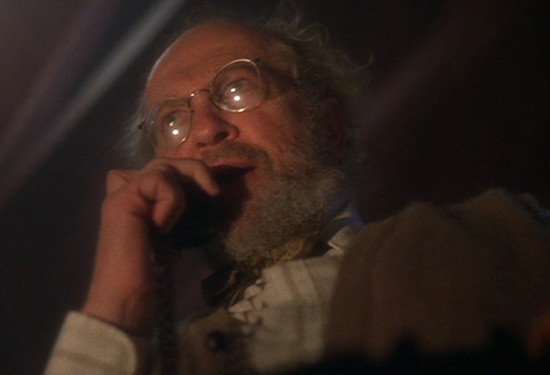
So the episode ends with a default standard monster movie scene, which may be the single least imaginative thing that has ever been done in any version of Dark Shadows. There’s a thunderstorm breaking loose, obviously, and Woodard is on the phone, desperately trying to get through to the Sheriff with his astounding breakthrough in the case.
And then the power suddenly cuts out, obviously, and the phone goes dead, obviously, because everyone knows that phones stop working when the lights go out.
And then Woodard picks up a flashlight, obviously, and creeps around the house, obviously, and accidentally steps on the cat, obviously, and hears a noise and goes to investigate it, obviously, and it turns out to be a shutter banging in the storm, obviously, and then he turns around, obviously, and he says, who’s there?
And guess what? The vampire’s there! And we can see all the way up his nose.
Tomorrow: Blind Date.
Next pre-emption special:
Time Travel, part 4: I Was Just Noticing Your Harpoon Collection.
— Danny Horn




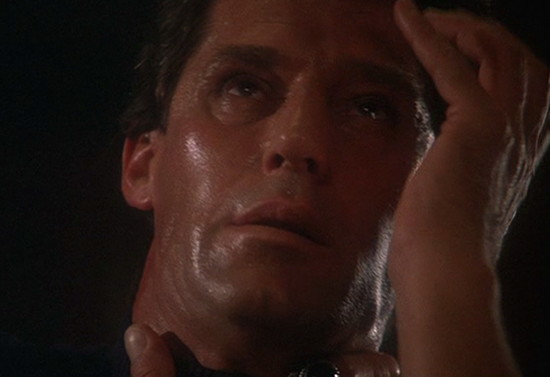




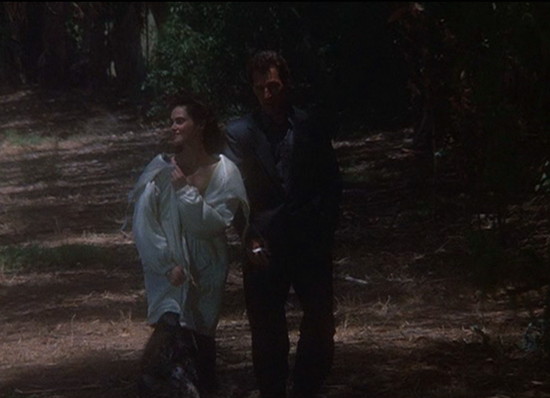

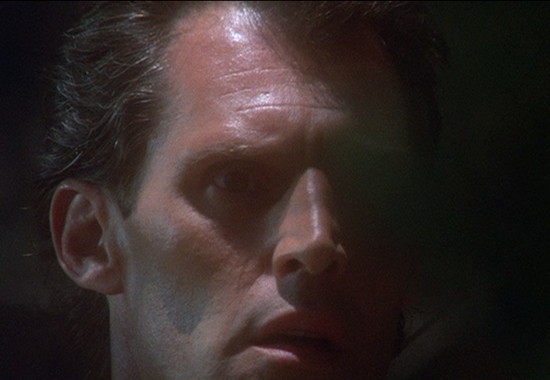
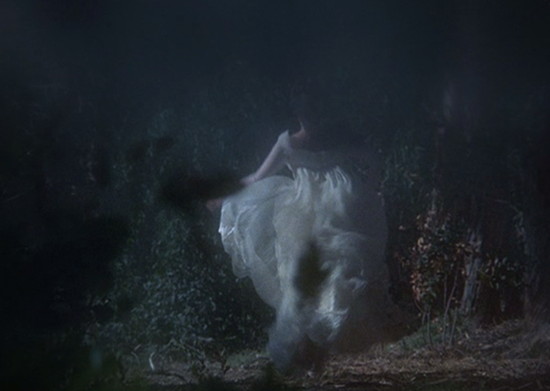
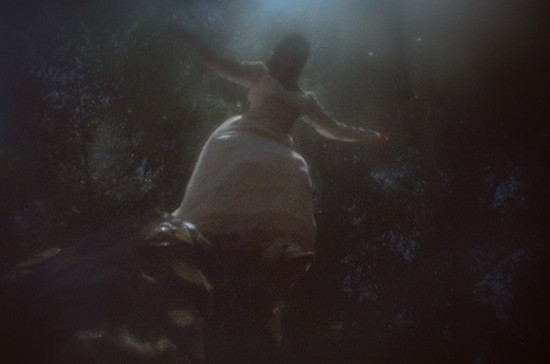
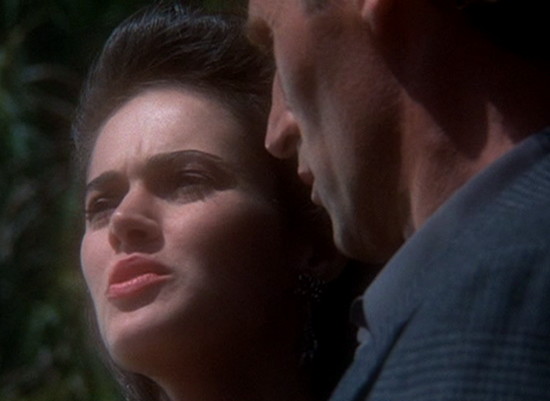
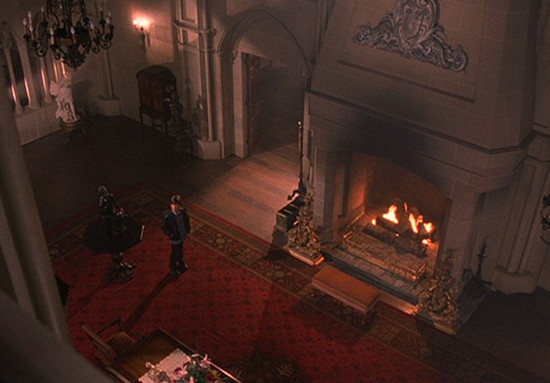
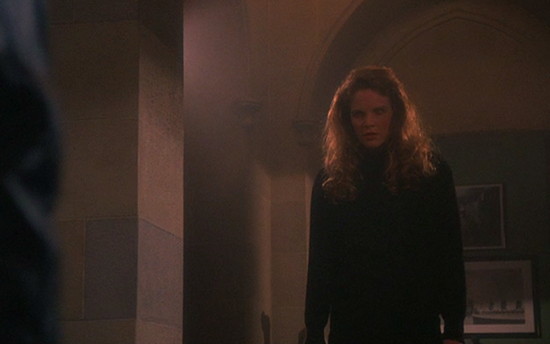


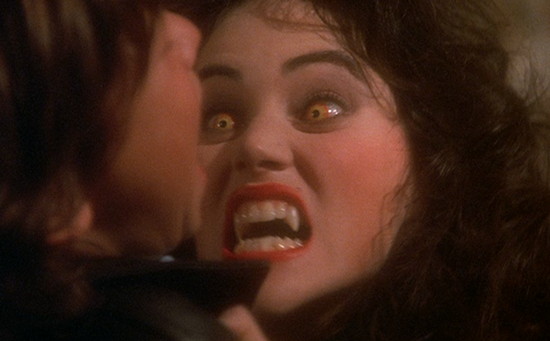


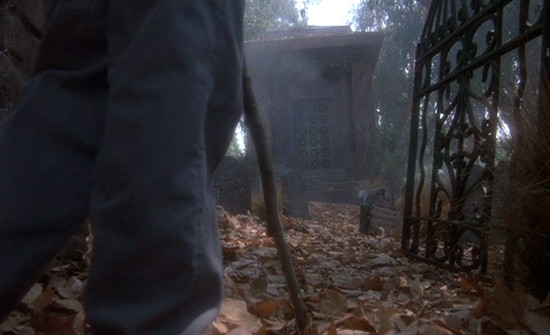
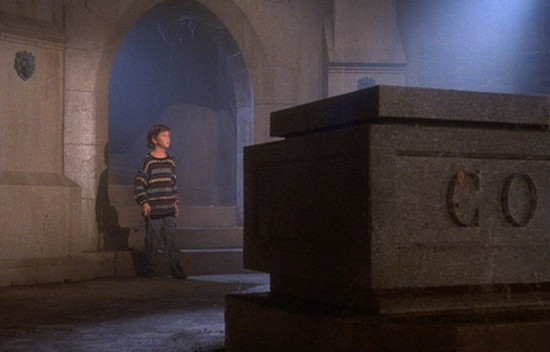



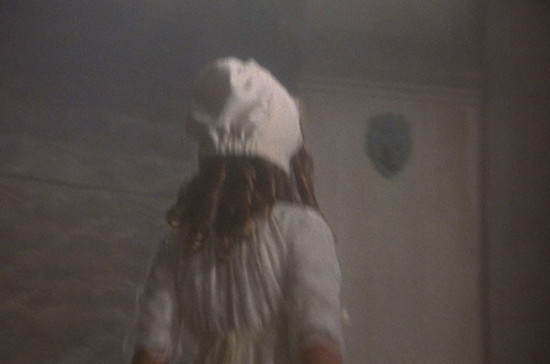







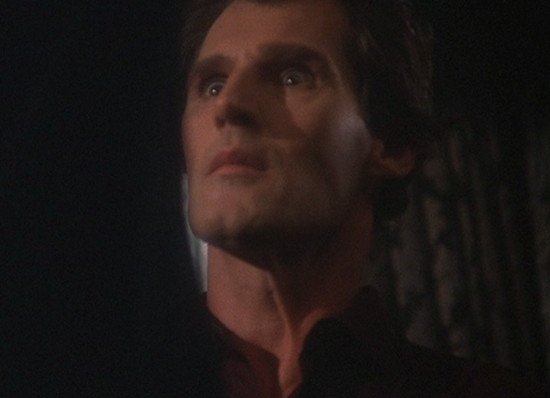



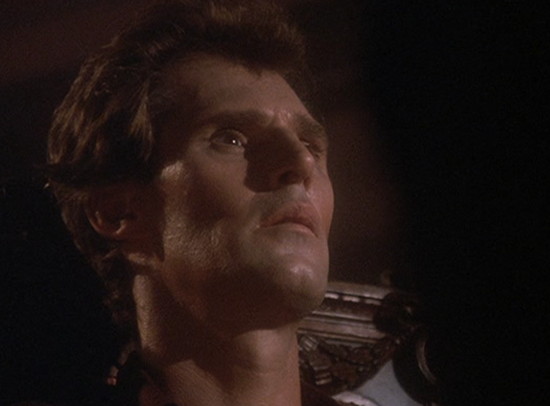

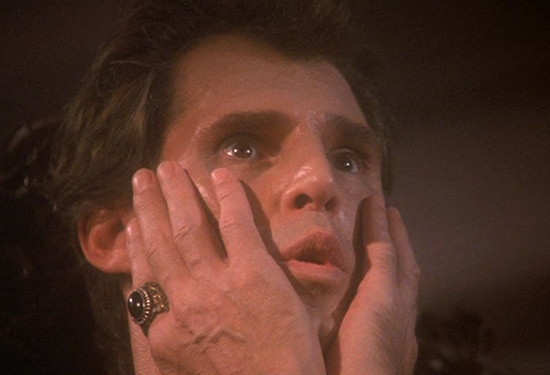
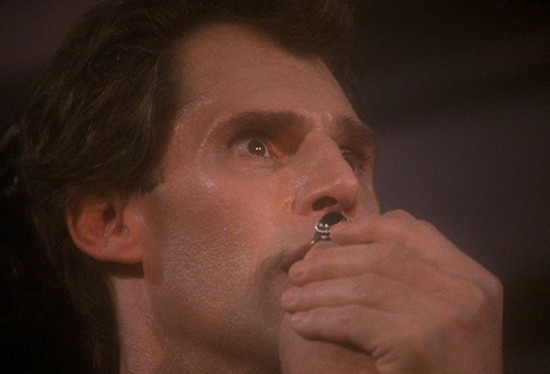
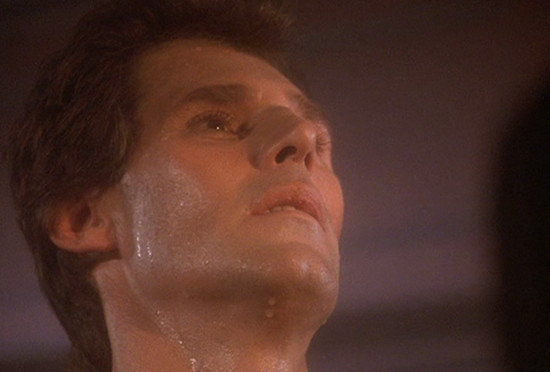
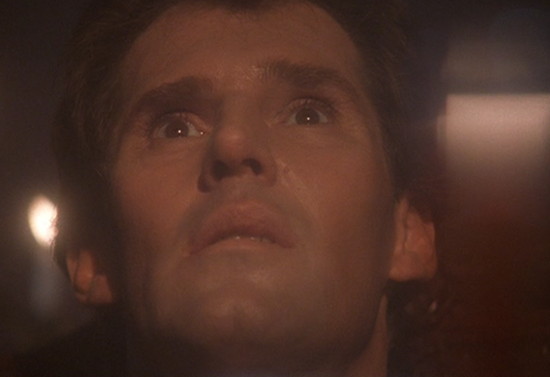




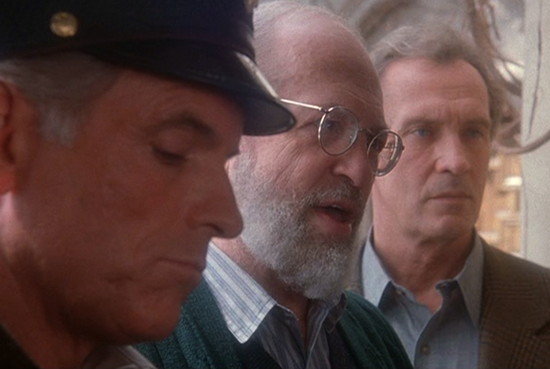

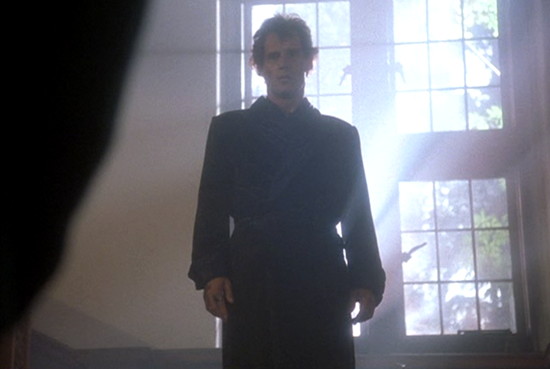

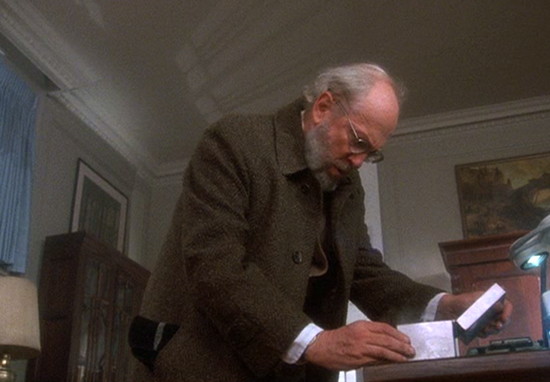
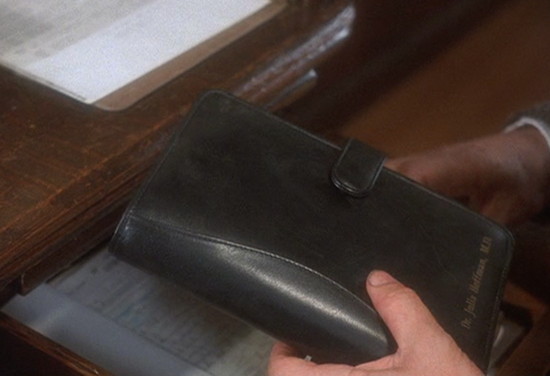
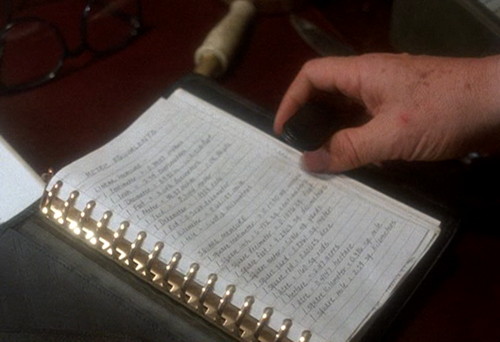




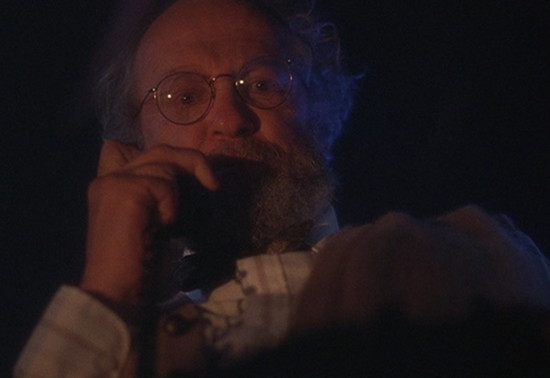



Thayer David, Louis Edmonds, Lara Parker, and Grayson Hall — yeah, good luck trying to make a version of DARK SHADOWS without personalities and presences at least on some equal footing. Professor Stokes could make reading the phone book interested. Professor Woodard is just… there. Let’s imagine what Edmonds as Roger Collins would have done in the confrontation scene at the Old House — in fact, we don’t have to imagine. We have something similar when Burke and Woodard confront Barnabas in 1967. Not only would Edmonds have been at his acerbic best, but he would have provided tension and conflict. He doesn’t want to insult his cousin over his son’s “foolishness.” Barbara Steele is never fun, and Grayson Hall as Julia always is — every facial expression, every scream, every ridiculous lie. And while Lysette Anthony will subject us to a weird French accent, Lara Parker was adorably evil as Angelique. There’s an upcoming scene in 1968 when she’s tormenting Elizabeth and when the poor woman runs off screaming, Cassandra just laughs like an otherwise innocent little girl. She loves her job.
You bring up a very good point that essentially DARK SHADOWS 1991 adapted plot elements from the original, in a weird Cliff’s Notes version of the show, without delving deeper and adapting character elements. So, Roger Collins stirs things up with a witty riposte. Stokes is smart and clever. Julia is the trickster character — if you distill them to simply “drunk brother of Elizabeth,” “guy who wants to expose Barnabas” and “doctor who wants to cure Barnabas,” you wind up with the flat, stale mess we received.
The Woodard plot is tragic because, as you say, it’s Julia’s “original sin” and means she can never go back (the “point of no return” in most good fiction). And in a stark contrast to Julia at that point, Woodard refuses to make a deal with the devil… either for knowledge and fame, as Julia did, or for his own life. In the 1991 series, Woodard — OFF SCREEN — decides to let Barnabas turn him into a vampire. If you don’t know your characters and their arcs, your plot-driven stories are going to fail.
Also, HODS could “expose” vampirism to the world and have Carolyn running around in her nightgown baring fangs and killing people because it was a two-hour horror film. It makes no sense to try to set your series in the modern world where people know about vampires — unless you’re going to go full BUFFY/ANGEL/hellmouth. The original series only did this in 1897 and 1840, and that worked because those time periods have a Universal Horror film to them.
The other big plot hole — and HODS had this as well — is that by having Carolyn/Daphne as vampires, you are establishing that perhaps Julia’s attempts to cure them is not a bad thing. Both Carolyn and Daphne were perfectly nice, non-psychotic people prior to becoming vampires and there’s no reason to think that Julia’s cure wouldn’t return them to their former state. There is tension for Barnabas in 1967 because the audience at the time and Woodard and everyone else had no reason to think that he wasn’t a rotter before becoming a vampire, as well.
I’m glad someone here has mentioned Barbara Steele by name (even in a critical way). I can’t understand why this blog has had so much to say about the ‘ 91 version, including the Julia character, without mentioning her by name, she being such a “horror icon.”
(The same is true of Jean Simmons, though without the “horror icon” part.)
I’m actually not very familiar with a lot of horror movies. I know about Dark Shadows because of my interests in other TV genres — science-fiction, fantasy, soap opera and comedy. I’ve read most of the literature that gets referenced in DS, and I really like the Universal Monsters movies, so that all ends up feeding into the blog entries.
The one area that I don’t really know well is the UK/European horror movies — Hammer Horror, or the Italian gothics. If they haven’t been featured on Mystery Science Theater 3000 or RiffTrax, then I don’t know them. This is the only thing I’ve ever seen with Barbara Steele, so the horror icon cachet passed me by.
Trust me, I came to Dark Shadows as a child because I think I was hatched loving horror movies. Barbara Steele is an icon. But.indeed, her greatest films were Euro-horror. As a interesting side-note, Ms. Steele was enticed back to horror by Dan Curtis because she produced his mini-series The Winds of War and War and Remembrance.
Hammer Horror is a genre all to itself. Peter Cushing and/or Christopher Lee presiding over a bright red blood soaked screen full of the heaving bosoms of the likes of Ingrid Pitt, Kate O’Mara and Madeline Smith. A late night pleasure on TV for an impressionable English boy!
Why is Vicki dressed up like the Michelin Man during her stroll with Barnabas? I have to get the DVD set of this series because I forgot most of these scenes and find it hard to comprehend the sequence of events as they are played out. Excellent reviews by Danny and Stephen – now I’m anticipating watching these episodes again.
I am trying to figurate how to create vials of exploding blood. They would be great for Halloween.
Is it me or is Sheriff Patterson wearing an obscene amount of make-up?
Maybe a fake tan? I remember tanning beds being all the rage back then in the pre-spray tan era. From the quick side view glance of the sheriff I did a double take since his profile reminded me of Dennis Patrick when he was playing grayer haired Paul Stoddard. Also is the guy on the other end supposed to be Roger Collins?
Television makers today have forgotten about the miniseries. They USED to be a big deal, appointment television. For example, it used to be a big deal when “Gone With the Wind” was shown over two nights and many complex books that couldn’t easily be summed up in an hour and a half would get a full 4 hour treatment or more and be a big ratings success, for example “North and South” in the mid-1980s. Unlike a regular series, miniseries have a beginning a middle and an end. I don’t think this one even approaches that, especially when the second half was made up of two individual episodes that couldn’t possibly have miniseries style pacing because that’s not how you write hour long television shows, they are self contained. By the early 1990s they had pretty much dried up, but I think television executives still hadn’t gotten over the idea that a miniseries was a big deal and I think that’s why they showed it and advertised it this way.
I watched the 1991 series without having seen the original, but I heard about it and I was really excited to see the new version and then disappointed because it didn’t make any sense.
Actually I’ve noticed a Renaissance of mini Series this year. Although they aren’t necessarily run over an entire week. But some of them are. This year I saw the remake of Roots and two different series about OJ Simpson
All those shots upward of Barnabas makes me want to shout “Up your nose, with a rubber hose!”
I think that miniseries were replaced by series with story arcs. A story arc has a beginning, a middle, and an end. In the meantime, the crisis of the day is handled. Babylon 5 showed the way, and it was a good one, so everyone followed.
Why didn’t Julia write her notes in some kind of shorthand or code? Even I know enough to do that when I am daydreaming and writing fiction or personal notes during long, dull staff meetings at work.
This series really blew it. Daphne could have been an interesting new character, but they had to swipe the Lucy plot from Dracula. This is esp. apparent when you see the Coppola version–Lucy feeds on children (in the original novel, too, though she doesn’t kill them) and David was apparently supposed to be her first victim. They could have done a lot with that, but tossed it out for shock value.
Wish we could see the 2004 (?) WB pilot. That made this one look like Citizen Kane, from what I hear.
This one is utterly devoid of the original’s charm and wit, which is what the audience loved, not the gore (same goes for the dreadful HODS).
They never explain why Daphne as a vampire is a feral animal and Barnabas has enough presence of mind to spend time remodeling an old house. Doing the Lucy from DRACULA plot, as you say, destroys any attempt to ground the series in reality.
And by reality, I mean an emotional reality. The Collins have a damn costume party just a few weeks after a family member is murdered and returns to life as an undead ghoul.
Maybe all those units of measurement were Julia’s shorthand code?
The original handling of Woodard WAS probably the emotional highpoint of the series. It was incredibly powerful, but alas, it did not allow for a follow up (because neither Barnabas or Julia was to be caught). So, it became another of those things forgotten after Vicky’s trip to the past, and left without a proper resolution.
There was a missed opportunity in 1968 when Cassandra passes on the Dream Curse to Barnabas and Julia slaps her – “you will regret that” Cassandra says. Well, Cassandra could get her haunted again, as when Barnabas did it, but much nastier. Like “How good is Barnabas in bed?… Oh, he has not done it? Not even a sympathy fuck, out of gratitude? I guess you are too ugly” And “I guess you demonstrated why women don’t belong in medicine” Sort of throwing a lot of her earlier insecurities back at her.
I’ve been continuing to think about the hiss, instead of being cats, with those eyes, the open mouth teeth protruding and being cold blooded, were they maybe supposed to be snakelike?
Also, the more I think about the stupider it seems to try to turn Barnabas human this early in the series. I mean we hadn’t even caught our breath from the fact Barnabas WAS a vampire and now you’re turning him back? What’s the point? Maybe if they tried to cure Daphne who was a nice if vague character who only just had turned I might have wanted them to succeed.
HODS made the same mistake, I think, in forgetting what was compelling about the cure storyline on the original series. TOS spent weeks building up Julia Hoffman as a smart, savvy doctor who is zooming in on the villain’s secret. Then we discover that she is focused solely on her own acclaim and is willing to sacrifice Maggie’s mental health in order to make a deal with the devil.
Julia shows up to cure Barnabas in HODS and the 1991 series so quickly we have no chance to feel the punch in the gut of a “face heel turn.” There’s also the contrivance of Julia even considering a method of curing vampirism. In TOS, the backstory is that this has been a consuming area of study for Julia, who latched onto Maggie’s case for that very reason.
The hissing vampire. This must have been something that Dan Curtis picked up along the way, after Dark Shadows. In The Night Stalker pilot movie, when Kolchak ventures to his house and confronts him in those final scenes, we hear the hissing and growling as Kolchak holds the crucifix before him, probably because Barry Atwater hadn’t had a single world of dialog in the entire movie. It might have just been a way of making him appear menacing and dangerous, since he didn’t have anything to say.
Miscellaneous note on props. The Ralston-Purina lamp, after being in episode 1, first appears at Collinwood in Liz’s room in episode 156. Her room is shown frequently in these episodes, as she’s convalescing after having been zapped by Laura the Phoenix. Whenever they do longshots of this room, whether from the foot of the bed or from the right side of the bed, they make sure to get the lamp in clear view. Perhaps the producers were indeed angling to get Ralston Purina as a sponsor. Also in Liz’s room is the Petofi box, which rests on the dressing table across from the foot of the bed. The lamp is back at the Collinsport Inn in episode 164, this time on the other end of the front desk nearest the door so that it can be included as background as Vicky talks with Dr. Guthrie about Laura Collins. The lamp first appears in the study at Collinwood in episode 169 when Roger has a talk with Frank Garner.
A note on reuse of sets. Around this time, Frank Garner’s office the same as Roger’s office at the cannery. Everything is the same. Same fireplace right inside the entrance, same desk and chairs, same furniture everywhere else and in the same place, same mustachioed “Smith Brother” portrait against the far wall, even the same bedpan-shaped barometer hanging on the wall near the door on stage left. The only thing that wasn’t there from Roger’s cannery office was the dartboard. In episode 169 in the Collinsport study, the bedpan barometer was also there. Apparently everyone wanted one, including the Ralston-Purina lamp.
One other note about the weather in Collinsport. You know, Collinsport, Maine, must be the only place in the entire Northeast where it never snows and has thunderstorms year-round, including February. A truly supernatural place indeed.
I noticed that too about the weather. I am currently watching another show about a girl trying to discover her past who goes to a small Maine town and encounters supernatural happenings…Not Dark Shadows but HAVEN. I noticed that the weather is always balmy on that show too – I guess it’s too much trouble to make up fake snow..
And it’s never Christmas. Or Thanksgiving. Just Halloween, year round.
It’s about this point in the revival series that I wonder why they didn’t just try a “Next Generation” type thing. If they’re not going to establish these characters because we think we know them already, why are they showing us this again?
I like your theory that Bush 41 started the war to distract from the terror of DARK SHADOWS 1991.
As you are diverting from the show today it seems like a good time to bring up a family connection with “Dark Shadows” I found out last week. In his younger days, my father wrote from a regional newspaper out of Davenport Iowa. At this job he had the opportunity to interview Jonathan Frid for an article over lunch, and my mom tagged along out of what, I assume, must have been morbid curiosity. Neither had really watched the show.
I was thrilled by this news. But my father described a somber scene that fits in with your description of Frid’s press tour (I don’t know if my father’s interview aligns with those days). He thought Frid was kind of boring. But my mother said that Frid was more bored by talking about the show than boring in and of himself. One can only imagine giving that interview to dozens of local newspapers, talking about a phenomenon that seems to have mystified Frid a bit. And Davenport, Iowa isn’t much of a town to visit either. I’d be a little dull too.
No, true. Taking the show seriously doesn’t necessarily mean being dour. I have a feeling that when the original cast said that, they meant that they gave it 100%, no matter how bizarre the story. In other words they were fully committed, and we feel the full impact of their charisma.
You wanna talk up-nose shots? Classic DS Julia had soooo many up-nose camera shots, most due to her tendency to tip her head back and look down her nose. It bugs me every time, along with her fish-mouth gaping, and the lip-pressing. She really overdoes it, constantly jarring me out of the story. I really don’t notice that sort of thing nearly as much with the other characters. Even Dr. Lang — who comes across well as mad scientist, at least for me.
Killing off Daphne was a big mistake. It would have been interesting to see her trying to adapt to her new vampire status. The series certainly had some beautiful actresses . Barbara Blackburn was memorable as carolyn. I think the show suffered from bad timing. If it had premiered just a few short years later it could have benefitted from the same vampire craze that maDE Buffy such a huge hit.
Your criticisms are spot on. I’ll add a few of my own. If any show screams for filming in Canada it’s a Dark Shadows revival. How dare they shoot this in LA. Some of the best TV was produced north of the border including The X-Files and the reimagined Battlestar Galactica, and production costs are lower there. Dark Shadows needs cloudy, overcast days and fall weather. And they shouldn’t have cheaped out doing that day-for-night thing; it just reemphasized how unappealing the show is. Why on earth did they kill Dr. Woodard so early – episode 3, come on! And yes, that was Julia’s sin. They should have had a much longer story arc, eliminated the Daphne character all together (including not killing someone so close so early in the series). The casting is a mess, though Jean Simmons was a good choice. And of course Joseph Gordon-Levitt as David. By making Vicki his principle love interest from the start means that there was never any Maggie-biting & abduction that led Dr. Hoffman to Collinwood. It took months for Woodard to piece together things. Even with a weekly series that could have been stretched out to week 10 or 13. Maybe the Woodard killing cliffhanger could have ended the first season. And you’re right about the sinus-cam and the humorless characters. And I still think they should have used story elements of mystery from the pre-Barnabas episodes when Vicki was smarter than she later became; those could have run parallel to the Barnabas storyline. So much potential wasted.